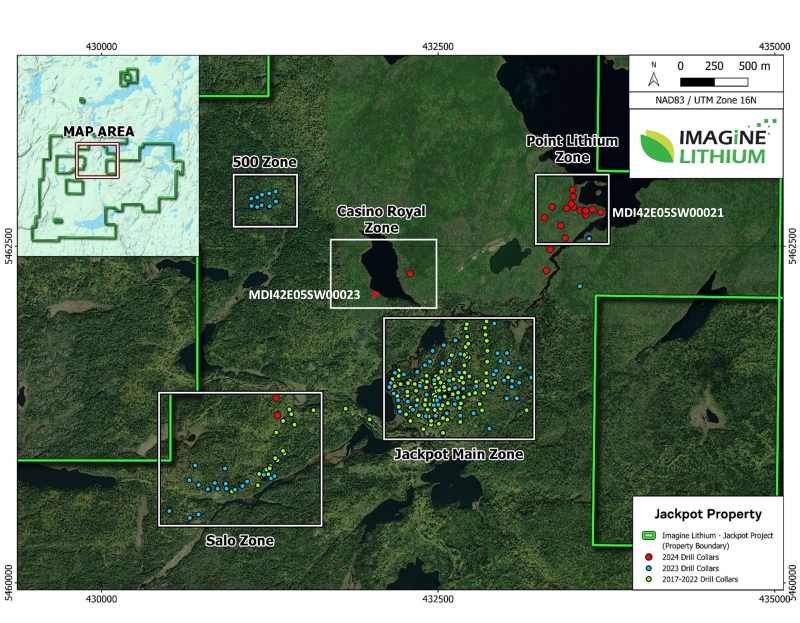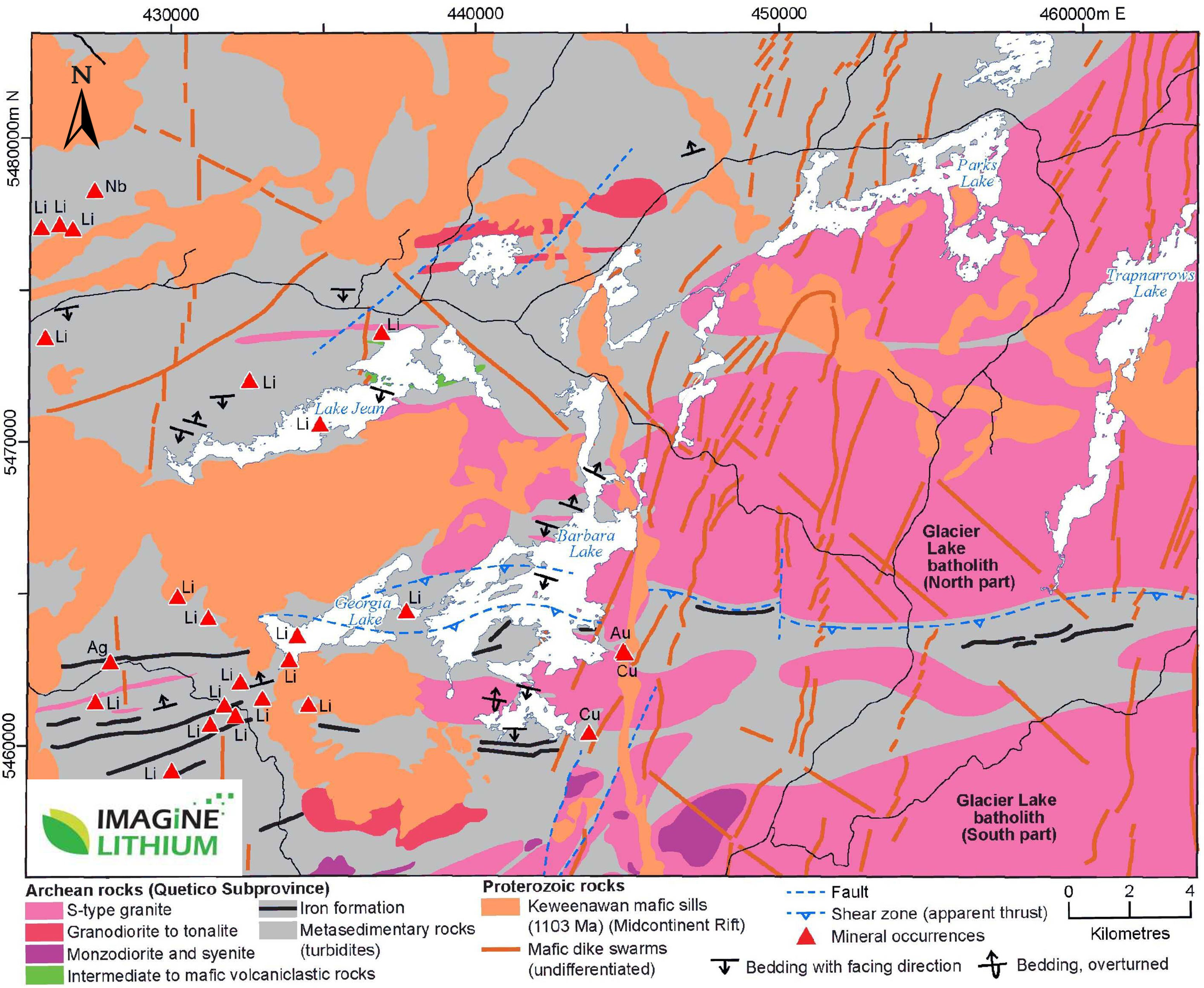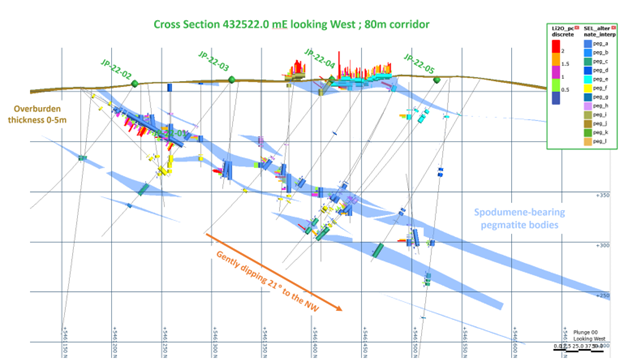The Jackpot Lithium property, located in the Georgia Lake Area about 140 km NNE of Thunder Bay, Ontario, is situated approximately 12 km by road from the TransCanada Highway (Hwy 11) and approximately 50 km from the town of Nipigon, on Lake Superior. The Main Jackpot Zone was reported to contain 2Mt @ 1.09 Li2O as estimated in 1956 by Ontario Lithium Company Limited*. Drilling since 2018 has been focused on expansion of historical resource at the Jackpot Main zone and other targets on the property, including the newly discovered Casino Royal zone.

Lithium was first discovered near Georgia Lake in 1955 within granitic pegmatites. The current Jackpot property covers the Jackpot and Newkirk-Vegan lithium deposits, described in a 1965 report by E.G. Pye published by the Ontario Department of Mines.
The Jackpot deposit was tested by a total of 32 diamond drill holes (~3,246 m) in 1955 by Ontario Lithium Company Limited, an associated company of Conwest Exploration Co. Ltd. The drilling confirmed the presence of at least two spodumene-bearing granitic pegmatite bodies, one at the surface (Dike No. 1) and a second body (Dike No. 2) lying beneath Dike No. 1.
Dike No. 1 is a 6 to 9 meters thick, flat-lying body occurring as outcrops and further exposed by historic trenching. A review of Ontario government assessment files suggest minimal drilling was completed on Dike No. 1 as efforts appear to have been focused on the larger (Dike No. 2). The 1955 drill logs extracted from archived files indicate assaying from only one drilled section within Dike No. 1 even though spodumene is identified in several drill logs. Records from DDH 428 intersected 1.47% Li2O over 3.96 m from the surface. The Company has not yet verified the reported assays. Dike No.1 represents a readily accessible target for trenching and bulk sampling and acquire sufficient material for metallurgical testing.
Dike No.2 is not exposed at surface and was discovered by diamond drilling. Dike No.2 has been described by Pye (1965) as follows: "... Historical drill intercepts include 1.52 per cent Li2O over 10.6 metres (drill hole 411) and 1.17 per cent Li2O over 21.2 metres from (drill hole 407)."
*All drill intercepts reported are historical in nature and are taken from assessment files available at the Ontario Ministry of Northern Development and Mines. The assay results have not been verified by Imagine Lithium. The estimates presented above are treated as historic information and have not been verified or relied upon for economic evaluation by the Company. These historical mineral resources do not refer to any category of sections 1.2 and 1.3 of the NI-43-101 Instrument such as mineral resources or mineral reserves as stated in the 2010 CIM Definition Standards on Mineral Resources and Mineral Reserves. The explanation lies in the inability by the Company to verify the data acquired by the various historical drilling campaigns. The Company has not done sufficient work yet to classify the historical estimates as current mineral resources or mineral reserves.

The Jackpot property is within the Quetico subprovince of the Superior province, which is bounded by the granite-greenstone Wabigoon subprovince to the north and the Wawa subprovince to the south. The Quetico subprovince consists of metasediments (wacke, iron formation, conglomerate, ultramafic wacke, and siltstone) laid down between 2.70 and 2.69 billion years ago. Igneous rocks include abundant felsic and intermediate intrusions and suites of gabbroic and ultramafic rocks. Late felsic intrusions are designated as S-type granitoids. The Quetico subprovince underwent four deformational events that involved regional shortening and dextral shearing. Metamorphism, migmatite formation and granite intrusion occurred between 2.67 and 2.65 billion years ago. Metamorphic grade varies from lower greenschist to amphibolite facies. An important deposit type consists of late-stage, Li-Be-Ta-Nb and Sn granitic pegmatites and the rare-element pegmatites are widely distributed in the Quetico subprovince. Granitic pegmatite dikes are hosted by metasediments and by their parent granitic plutons.

The geology of the Georgia Lake area that includes the Jackpot property was thoroughly mapped and described by Pye in 1965.
The oldest rocks are Archean metasediments forming a dark grey, granoblastic to porphyroblastic schist or gneiss composed of biotite-quartz-feldspar ± garnet ± cordierite ± staurolite. The metasediments strike east-northeast and in general dip steeply to the north. The metasedimentary assemblage displays a distinct banded appearance due to compositional variations reflecting an original sedimentary stratification, with individual layers less than 2-3 cm to a few meters thick.
The metasediments were intruded by large masses of granitic rocks and by numerous sills and dikes of genetically related porphyry, pegmatite, and aplite. The granitic rocks are equigranular occasionally porphyritic with microcline phenocrysts. They are pale-grey or pale pink in color and contain 45-65 vol.% feldspar (microcline and plagioclase), 40 vol.% quartz, and one or both of muscovite and biotite and rarely hornblende. The contacts between the equigranular granitic rocks and the metasediments are generally sharp.

Granitic pegmatites dikes and bodies are abundant close to and within the large masses of granitic rocks. A regional zoning is apparent, and a genetic association of pegmatites and granite is indicated. The pegmatites occur in two geometries: as irregular-shaped bodies and as thin dikes, sills, and attenuated lenses. The irregular bodies of pegmatite are intimately associated with the granite bodies often within a few hundred feet of the contact zone. They typically are medium to coarse-grained, up to very coarse-grained and are made up of quartz, microcline, perthite and little muscovite. These would be classified as potassic pegmatites. Accessory minerals include biotite, tourmaline, beryl, and garnet.
The pegmatite dikes, sills and lenses can be subdivided into rare-element pegmatites and granitic pegmatites. The rare-element pegmatites are of economic significance, and they contain microcline or perthite, albite, quartz, muscovite, spodumene and minor amounts of beryl, columbite-tantalite, cassiterite and apatite. Some of the pegmatites are parallel to the foliation or bedding of the metasediments, whereas others occur in joints in either the metasediments or granites. Contacts are usually sharp and, except where dikes cut granitic rocks, often found to be marked by a thin border zone of aplitic or granitoid composition. A few pegmatites are internally zoned with mica-rich or tourmaline-rich rock along or close to the walls and quartz cores.
Intrusive into the Archean rocks are bodies of Proterozoic diabase sills. The largest occur as flat sheets (Logan sills), up to about 200 m in thickness, and as dikes of vertical or near-vertical attitude. Most of the dikes are related closely to the sheets and are Keweenawan in age. The gently dipping diabase sheets are dark colored and massive. They are well-jointed and most of the joints are vertical or steeply dipping. In outcrop, the diabase shows poorly formed columnar structure.
Diabase dikes are equigranular or porphyritic, with the former being more abundant. The porphyritic diabase dikes, found on the Jackpot property, are massive and medium-grained, dark-colored rocks characterized by pale-greenish yellow phenocrysts of highly altered plagioclase.
The principal mineral constituents of the Jackpot spodumene-bearing granitic pegmatites are quartz, feldspar and spodumene with minor amounts of muscovite. Accessory minerals include apatite, beryl, garnet, and tantalite. Quartz is often interstitial and occasionally intergrown with K-feldspar to form a graphic texture. The pegmatite dikes contain 5-10% fine to medium grained silver to light green muscovite occasionally forming veinlets. Crystals of feldspar and spodumene are randomly distributed arrangement. K-feldspar is white and occurs in crystals small plates or large rectangular crystals (up to 1 m-long). Albite form cm-size elongated laths.
Spodumene varies in color from buff white to pale apple green color when fresh and becomes greyish/blackish or cream in color when altered. Spodumene may show alteration defined by flakes of dark green, very fine-grained micas. Elongated medium to very coarse grained spodumene is up to 45 cm long and usually interstitial with quartz with intergrowth textures. The granitic pegmatite dikes are poorly zoned and occasionally display fine grained sugary albite, muscovite, black tantalite, and blue fluor-apatite in aplite at the pegmatite wallrock contact. Coarse-grained, spodumene-bearing zone at may occur at the core of the dikes.
The Jackpot Main zone has been the focus of exploration drilling on the broader Jackpot property. In 1956, a historical resource of 2 Mt grading 1.09% Li2O was estimated based on drilling from 1955. Imagine Lithium conducted drill programs in 2018, and 2022-2024 aimed at confirming and expanding historical resources. Over 39,000 meters of drilling have been completed to date on the Jackpot Main zone.
The deposit consists of a swam of mineralized, spodumene bearing, pegmatite dikes that are shallow dipping to the north. Modern drilling has extended the swarm by 400 m along strike, tracing it over a 900 m strike, 300 m down dip and to a depth of 200 m. A flat lying pegmatite is exposed at surface and traced over several hundred meters. A broadly distributed pegmatite ranging from 3 to 25 meters in thickness, dips below the surface at a shallow 21-degree slope. A similar dike is located to the north of these first two, overlying them stratigraphically, and also dips shallowly to the north. A number of pegmatite lenses may be interspersed between, above, and below these broader dikes.

Highlighted assay results from the channel sampling and drilling programs are presented below:
Highlights of the assay results include:
Please refer to the following news releases for full results:
The Casino Royale zone was drilled in 2024 and to date has traced a pegmatite ranging in thickness between 3 m and 19 m over 200 m. Surface sampling does provide potential for this zone to extend 900 m and may contain several stacked and/or folded pegmatites. Additional drill testing is required to test and define this zone.

Highlighted assay results from the channel sampling and drilling programs are presented below:
Please refer to the following news releases for full results:
Sampling and prospecting programs identified a 3 km trend of sub-parallel spodumene-bearing pegmatite dikes that extends to the east and west of the Jackpot main drilling area. The figure below outlines the approximately 18,800-hectare Jackpot Lithium property and trend.
Assay results from 57 granitic pegmatite samples collected from the south-west of Jackpot contain multiple high grade Li2O grab samples (see press release for sample results).

Drilling in the area intercepted 3.01 m @ 2.02% Li2O in hole SW-2023-03B and 3.02 m @ 1.02% Li2O in hole SW-2023-03 with targets in the area remaining to be tested.
The 500 and the Point Lithium zones, along with the Casino Royale zone, may be continuations of the Jackpot Mains zone dike swarm to the north and may be connected or parallel to each other, with over 2 km of untested strike between them. Drilling at the 500 zone intercepted 4.15 m @ 0.58% Li2O with the dike remaining open to the east. Results from the 500 and Salo (SW) zones are summarized in the October 24, 2023 news release.
